 Large-scale methane measurements on individual ruminants for genetic evaluations
Large-scale methane measurements on individual ruminants for genetic evaluations
STSM – Marcin Szalanski from Poland visited Nottingham University, UK.
My name is Marcin Szalanski. I am a master’s degree student at the Poznan University of Life Sciences (PULS) in Poznan, Poland. In the last year of my studies I became interested in the quantitative genetics approach as a mitigation strategy for ruminant enteric methane emissions. Currently, I am writing my master thesis titled “Variability of dairy cows’ methane emission from individual breath measurements”. It will be a part of a project realized in Department of Genetics and Animal Breeding at my home university.With the support of METHAGENE COST Action I had an opportunity to visit Sutton Bonington Campus of the University of Nottingham (UN) for five days. I was welcomed by the team of prof. Phil Garnsworthy. The main goal of my STSM was the comparison between two different sniffer-based systems of measuring enteric methane emission from dairy cows. The comparison was focused on both the measuring equipment and even more on data collecting and processing.
On the first day, I visited the respiration chambers. Everyone of them can accommodate three sheep or one cow. The open-circuit measurement with NDIR (Non Dispersive Infra Red) analyser is used at UN and also the sniffer measurement nozzles are placed in the chamber to allow simultaneous measurement with this method. Next, I was introduced to the methane data analysis system. Team of prof. Garnsworthy uses Methane Peak Analyser written by Adam Garnsworthy to select and analyse every eructation peak. I got familiar with raw data and data processed by the program.
On the second day I went to the University farm. The staff introduced me to different aspects of farm management including nutrition, milking system, rearing and others. The facility possess equipment used for different experiments, i.e. feed bins used for measuring dry matter intake (DMI) and the NDIR analyser for measuring methane emissions. The methane emissions measuring system is installed in the milking robot (Lely Astronaut A3). There are four installations at the University farm. I inspected the differences between this NDIR system and the FTIR system we use at PULS. The FTIR analyser can estimate emissions of many gases simultaneously and there is no problem of humidity thanks to heated air duct. However, the FTIR method has one major disadvantage which is the longer reaction time.
 On the third day, I have had interesting discussions with the UN team members about data collecting and processing system. The main
issue is to join data from gas analysers loggers with the data from Lely system. This is done in multiple steps, with the use of
different programs. This system is more or less similar both at UN and at PULS. The reaction time problem was also discussed this day.
In certain situations it can result in underestimation of data output.
On the third day, I have had interesting discussions with the UN team members about data collecting and processing system. The main
issue is to join data from gas analysers loggers with the data from Lely system. This is done in multiple steps, with the use of
different programs. This system is more or less similar both at UN and at PULS. The reaction time problem was also discussed this day.
In certain situations it can result in underestimation of data output.
In the last two days I was focused on data analysis. My main efforts were focused on adopting data processing methods from British team into my data analysis to make data sets more comparable to each other. This is not an easy task. It requires familiarity with several programming languages and these days were very short time to do everything what I intended. Despite of that, I managed to establish a solid basis for current development of my analysis. The STSM showed me a solution to some problems which were a concern and created a good start for future cooperation in developing new, better methods for methane databases analysis.


